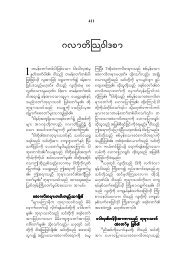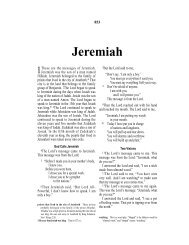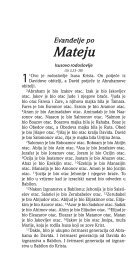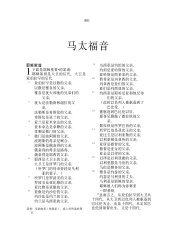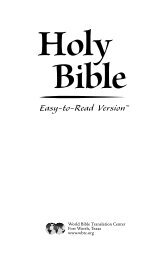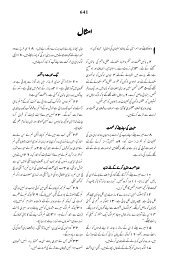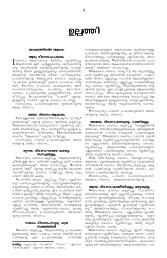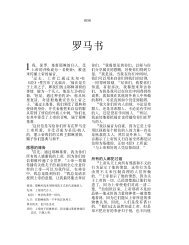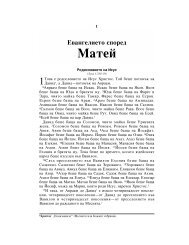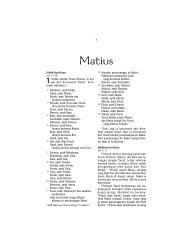English Version for the Deaf
English Version for the Deaf
English Version for the Deaf
Create successful ePaper yourself
Turn your PDF publications into a flip-book with our unique Google optimized e-Paper software.
Holy<br />
Bible<br />
<strong>English</strong> <strong>Version</strong><br />
<strong>for</strong> <strong>the</strong> <strong>Deaf</strong><br />
Translated from <strong>the</strong><br />
original languages<br />
World Bible Translation Center, Inc.<br />
Fort Worth,Texas
Holy Bible: <strong>English</strong> <strong>Version</strong> <strong>for</strong> <strong>the</strong> <strong>Deaf</strong><br />
© Copyright 2003 World Bible Translation Center<br />
All rights reserved<br />
This copyrighted material may be quoted up to 1000 verses without written permission.<br />
However, <strong>the</strong> extent of quotation must not comprise a complete book nor<br />
should it amount to more than 50% of <strong>the</strong> work in which it is quoted. This copyright<br />
notice must appear on <strong>the</strong> title or copyright page:<br />
Taken from <strong>the</strong> Holy Bible: <strong>English</strong> <strong>Version</strong> <strong>for</strong> <strong>the</strong> <strong>Deaf</strong> (EVD)<br />
© 2003 by World Bible Translation Center, Inc. and used by permission.<br />
When quotations from <strong>the</strong> EVD are used in non-saleable media, such as church<br />
bulletins, orders of service, posters, transparencies or similar media, a complete<br />
copyright notice is not required, but <strong>the</strong> initials (EVD) must appear at <strong>the</strong> end of each<br />
quotation.<br />
Requests <strong>for</strong> permission to use quotations or reprints in excess of 1000 verses or<br />
more than 50% of <strong>the</strong> work in which <strong>the</strong>y are quoted, or o<strong>the</strong>r permission requests,<br />
must be directed to and approved in writing by World Bible Translation Center, Inc.<br />
World Bible Translation Center, Inc.<br />
P.O. Box 820648<br />
Fort Worth, Texas 76182-0648<br />
bibles@wbtc.com<br />
Download free electronic copies of<br />
World Bible Translation Center’s Bibles<br />
and New Testaments at:<br />
www.wbtc.org<br />
ISBN Cover<br />
1-932438-15-7 Flexcover<br />
1-932438-16-5 Hardcover<br />
If you have received this Bible as a gift, it has been provided<br />
through <strong>the</strong> generosity of friends and partners of World Bible<br />
Translation Center. World Bible Translation Center exists to<br />
translate and distribute easy-to-read editions of God’s Word in<br />
<strong>the</strong> world’s major languages. If you have purchased this Bible,<br />
you will be glad to know that a portion of <strong>the</strong> purchase price<br />
has gone to send God’s Word to people around <strong>the</strong> world.<br />
If you would like to give additional support to World Bible<br />
Translation Center, you may send it to <strong>the</strong> address on this page.
Contents<br />
Preface v<br />
Introduction vii<br />
Old Testament<br />
Genesis 1<br />
Exodus 60<br />
Leviticus 113<br />
Numbers 152<br />
Deuteronomy 203<br />
Joshua 247<br />
Judges 276<br />
Ruth 309<br />
1 Samuel 314<br />
2 Samuel 354<br />
1 Kings 388<br />
2 Kings 426<br />
1 Chronicles 465<br />
2 Chronicles 504<br />
Ezra 549<br />
Nehemiah 562<br />
Es<strong>the</strong>r 581<br />
Job 591<br />
Psalms 630<br />
Proverbs 728<br />
Ecclesiastes 755<br />
Song of Solomon 766<br />
Isaiah 774<br />
Jeremiah 853<br />
Lamentations 942<br />
Ezekiel 951<br />
Daniel 1015<br />
Hosea 1035<br />
Joel 1047<br />
Amos 1052<br />
Obadiah 1062<br />
Jonah 1064<br />
Micah 1067<br />
Nahum 1076<br />
Habakkuk 1080<br />
Zephaniah 1084<br />
Haggai 1088<br />
Zechariah 1091<br />
Malachi 1102<br />
New Testament<br />
Mat<strong>the</strong>w 1109<br />
Mark 1156<br />
Luke 1185<br />
John 1232<br />
Acts 1265<br />
Romans 1311<br />
1 Corinthians 1330<br />
2 Corinthians 1347<br />
Galatians 1358<br />
Ephesians 1365<br />
Philippians 1372<br />
Colossians 1377<br />
1 Thessalonians 1382<br />
2 Thessalonians 1386<br />
1 Timothy 1389<br />
2 Timothy 1395<br />
Titus 1399<br />
Philemon 1402<br />
Hebrews 1403<br />
James 1419<br />
1 Peter 1424<br />
2 Peter 1430<br />
1 John 1434<br />
2 John 1439<br />
3 John 1440<br />
Jude 1441<br />
Revelation 1443<br />
Maps 1467
Contents<br />
In alphabetical order with abbreviations<br />
Acts Acts 1265<br />
Amos Amos 1052<br />
Colossians Col. 1377<br />
1 Chronicles 1 Chron. 465<br />
2 Chronicles 2 Chron. 504<br />
1 Corinthians 1 Cor. 1330<br />
2 Corinthians 2 Cor. 1347<br />
Daniel Dan. 835<br />
Deuteronomy Deut. 203<br />
Ecclesiastes Ecc. 621<br />
Ephesians Eph. 1365<br />
Es<strong>the</strong>r Es<strong>the</strong>r 581<br />
Exodus Ex. 60<br />
Ezekiel Ezek. 781<br />
Ezra Ezra 549<br />
Galatians Gal. 1358<br />
Genesis Gen. 1<br />
Habakkuk Hab. 1080<br />
Haggai Hag. 1088<br />
Hebrews Heb. 1403<br />
Hosea Hos. 852<br />
Isaiah Isa. 637<br />
James Jas. 1419<br />
Jeremiah Jer. 700<br />
Job Job 591<br />
Joel Joel 1047<br />
John Jn. 1232<br />
1 John 1 Jn. 1434<br />
2 John 2 Jn. 1439<br />
3 John 3 Jn. 1440<br />
Jonah Jonah 1064<br />
Joshua Josh. 247<br />
Jude Jude 1441<br />
New Testament books are in italics.<br />
Judges Judges 276<br />
1 Kings 1 Kings 388<br />
2 Kings 2 Kings 426<br />
Lamentations Lam. 774<br />
Leviticus Lev. 113<br />
Luke Lk. 1185<br />
Malachi Mal. 1102<br />
Mark Mk. 1156<br />
Mat<strong>the</strong>w Mt. 1109<br />
Micah Micah 1067<br />
Nahum Nahum 1076<br />
Nehemiah Neh. 562<br />
Numbers Num. 152<br />
Obadiah Obad. 1062<br />
1 Peter 1 Pet. 1424<br />
2 Peter 2 Pet. 1430<br />
Philemon Phm. 1402<br />
Philippians Php. 1372<br />
Proverbs Prov. 599<br />
Psalms Ps. 519<br />
Revelation Rev. 1443<br />
Romans Rom. 1311<br />
Ruth Ruth 309<br />
1 Samuel 1 Sam. 314<br />
2 Samuel 2 Sam. 354<br />
Song of Solomon S. of S. 630<br />
1 Thessalonians 1 Th. 1382<br />
2 Thessalonians 2 Th. 1386<br />
1 Timothy 1 Tim. 1389<br />
2 Timothy 2 Tim. 1395<br />
Titus Titus 1399<br />
Zechariah Zech. 1091<br />
Zephaniah Zeph. 1084<br />
All Scripture is given by God. And all Scripture is useful <strong>for</strong> teaching and <strong>for</strong> showing<br />
people <strong>the</strong> things that are wrong in <strong>the</strong>ir lives. It is useful <strong>for</strong> correcting faults and<br />
teaching how to live right.<br />
2 Timothy 3:16
v<br />
Preface<br />
This version of <strong>the</strong> Bible has been prepared especially <strong>for</strong> people who are<br />
deaf. It is important that everyone have <strong>the</strong> Bible in a language <strong>the</strong>y understand.<br />
But existing <strong>English</strong> versions do not meet <strong>the</strong> special needs of most<br />
deaf people, because <strong>the</strong> deaf have not had <strong>the</strong> advantage of constant exposure<br />
to <strong>the</strong> spoken language in developing <strong>the</strong>ir knowledge and usage of<br />
<strong>English</strong>.<br />
The <strong>English</strong> <strong>Version</strong> <strong>for</strong> <strong>the</strong> <strong>Deaf</strong> is not a revision of any <strong>English</strong> version<br />
designed <strong>for</strong> <strong>the</strong> hearing. It is an original translation based on <strong>the</strong> Hebrew<br />
and Greek Biblical texts. The wording will often strike <strong>the</strong> reader as different<br />
from o<strong>the</strong>r <strong>English</strong> translations, but it accurately expresses <strong>the</strong> full<br />
meaning of <strong>the</strong> original text in a style that is clear and easy to understand.<br />
The writers of Scripture, especially those who produced <strong>the</strong> New Testament<br />
writings, showed by <strong>the</strong> common language style <strong>the</strong>y used that <strong>the</strong>y were<br />
interested in good communication. The translators of this <strong>English</strong> version<br />
considered <strong>the</strong>ir example to be an important one to follow. So <strong>the</strong>y worked<br />
to express <strong>the</strong> meaning of <strong>the</strong> Biblical text in a <strong>for</strong>m that would be simple<br />
and natural. They used language that would not be a hindrance to understanding,<br />
but would provide a key to unlock <strong>the</strong> truths of Scripture <strong>for</strong><br />
people whose experience with <strong>English</strong> has been limited.<br />
Although <strong>the</strong> full meaning of <strong>the</strong> original text is expressed in <strong>the</strong> translation,<br />
<strong>the</strong> sense of <strong>the</strong> original has been restructured into <strong>the</strong> closest natural<br />
equivalents in <strong>English</strong> <strong>for</strong> <strong>the</strong> deaf community. For example, pronouns such<br />
as "he," "she," and "<strong>the</strong>y" are usually replaced with proper names, as is <strong>the</strong><br />
practice in sign language. Many common idioms used in spoken <strong>English</strong> are<br />
avoided, such as, "They got mad," which might be expressed instead as<br />
"They became angry." The result is an <strong>English</strong> translation that communicates<br />
more effectively to <strong>the</strong> deaf.<br />
The use of <strong>English</strong> was, of course, a practical necessity. But great care was<br />
taken to speak primarily to <strong>the</strong> deaf and not to <strong>the</strong> hearing. With <strong>the</strong> help of<br />
consultants familiar with deaf communication patterns, <strong>the</strong> translators<br />
attempted to match those patterns in <strong>English</strong> as closely as possible. They<br />
also benefited from testing done in different regions of <strong>the</strong> United States to<br />
determine a vocabulary familiar to most deaf readers.<br />
The result might appear to be just a simple <strong>English</strong> version of <strong>the</strong> Bible, but
PREFACE vi<br />
is much more than that. It is a carefully constructed translation, designed to<br />
communicate to those who are deaf. Although <strong>the</strong> language used will not be<br />
familiar to those accustomed to standard <strong>English</strong> versions, it does convey to<br />
<strong>the</strong> deaf <strong>the</strong> meaning that was originally intended.<br />
It is <strong>the</strong> purpose of this translation to provide <strong>the</strong> deaf with <strong>the</strong>ir own Bible<br />
<strong>for</strong> personal reading and study and to aid <strong>the</strong> vital ministry of those who<br />
teach <strong>the</strong> deaf, giving <strong>the</strong>m relief from <strong>the</strong> need to "translate" existing<br />
<strong>English</strong> versions as <strong>the</strong>y teach.<br />
The translation is based directly on <strong>the</strong> original languages of Scripture. In<br />
<strong>the</strong> case of <strong>the</strong> Old Testament, <strong>the</strong> translators followed <strong>the</strong> Hebrew<br />
Masoretic Text as it is found in <strong>the</strong> latest printed edition of Biblia Hebraica<br />
Stuttgartensia (1984), while referring occasionally to some earlier readings<br />
in <strong>the</strong> Dead Sea Scrolls. In some cases, <strong>the</strong>y also followed <strong>the</strong> Septuagint<br />
(LXX), <strong>the</strong> Greek translation of <strong>the</strong> Old Testament, where it has readings<br />
that are actually earlier than any known Hebrew manuscript. For <strong>the</strong> New<br />
Testament, <strong>the</strong> source text was that which is found in both <strong>the</strong> United Bible<br />
Societies' Greek New Testament (third edition, 1975 and fourth revised edition,<br />
1993) and <strong>the</strong> Nestle-Aland Novum Testamentum Graece (twenty-seventh<br />
edition, 1993). The occasional variation from <strong>the</strong>se printed editions<br />
was guided by reference to <strong>the</strong> findings of more recent scholarship.<br />
Several special features are used to aid understanding. Brief explanations or<br />
synonyms (italicized within paren<strong>the</strong>ses) sometimes follow difficult or<br />
ambiguous words in <strong>the</strong> text. Words or phrases that need fuller explanation<br />
are followed by an asterisk (*) and explained in footnotes at <strong>the</strong> bottom of<br />
<strong>the</strong> page. In addition, footnotes often identify Scripture quotations or give<br />
alternate readings when significant differences occur in <strong>the</strong> ancient<br />
manuscripts.<br />
As in all translations, words that are implied by <strong>the</strong> context are often supplied<br />
in <strong>the</strong> text to make <strong>the</strong> meaning clear. For example, <strong>the</strong> phrase that in<br />
Greek is simply "David of Jesse" is always translated into <strong>English</strong> as<br />
"David <strong>the</strong> son of Jesse." If such explanatory words or phrases are extensive<br />
or unusual, <strong>the</strong>y may be marked by half brackets. For example, in <strong>the</strong> translation,<br />
"The Lord gave this command to Moses {<strong>for</strong> <strong>the</strong> people}," <strong>the</strong> phrase<br />
in half brackets is added to avoid any misunderstanding that <strong>the</strong> Lord's command<br />
was intended only <strong>for</strong> Moses and not <strong>for</strong> all <strong>the</strong> people.<br />
Finally, in <strong>the</strong> Gospels, <strong>the</strong> first four books of <strong>the</strong> New Testament, <strong>the</strong> section<br />
headings are often followed by cross references. These identify where<br />
<strong>the</strong> same or similar material is found in one or more of <strong>the</strong> o<strong>the</strong>r Gospels.
vii<br />
Introduction<br />
The word Bible comes from a Greek word meaning “books.” The Bible is actually<br />
two collections of books, often referred to as <strong>the</strong> “Old Testament” and <strong>the</strong> “New<br />
Testament.” The word translated “testament” was used to mean a covenant or agreement.<br />
It refers to God’s promise to bless his people. The Old Testament is <strong>the</strong> collection<br />
of writings that relate to <strong>the</strong> agreement that God made with <strong>the</strong> descendants of<br />
Jacob (Israel) in <strong>the</strong> time of Moses. The New Testament is <strong>the</strong> collection of writings<br />
that relate to <strong>the</strong> agreement God made with all people who believe in Jesus Christ.<br />
The Old Testament writings tell about <strong>the</strong> great things God did <strong>for</strong> <strong>the</strong> people of<br />
Israel and his plan <strong>for</strong> using <strong>the</strong>m to bring his blessings to <strong>the</strong> whole world. These<br />
writings look <strong>for</strong>ward to <strong>the</strong> coming of a savior or “Messiah” (see “Christ” in <strong>the</strong><br />
Word List). The New Testament writings continue <strong>the</strong> Old Testament story. They<br />
describe <strong>the</strong> coming of that savior (Jesus Christ) and <strong>the</strong> meaning of his coming <strong>for</strong><br />
all people. The Old Testament is important <strong>for</strong> understanding <strong>the</strong> New Testament,<br />
since it provides <strong>the</strong> necessary background. And <strong>the</strong> New Testament completes <strong>the</strong><br />
story of salvation that began in <strong>the</strong> Old Testament.<br />
THE OLD TESTAMENT<br />
The Old Testament writings are a collection of thirty-nine different books produced<br />
by many different authors. They were written mainly in Hebrew, <strong>the</strong> language of<br />
ancient Israel. There are a few sections in Aramaic, an international language in<br />
Bible times. Portions of <strong>the</strong> Old Testament were written over 3500 years ago, and<br />
more than 1000 years passed between <strong>the</strong> writing of <strong>the</strong> first book and <strong>the</strong> last. In this<br />
collection <strong>the</strong>re are books of law, history, prose, songs, poetry, and wise sayings.<br />
The Old Testament is often divided into three main sections: <strong>the</strong> Law, <strong>the</strong> Prophets,<br />
and <strong>the</strong> Holy Writings. The Law contains five books called “The Five Books of<br />
Moses.” The first book is Genesis. It tells about <strong>the</strong> beginning of <strong>the</strong> world as we<br />
know it, <strong>the</strong> first man and woman, and <strong>the</strong>ir first sin against God. It tells about <strong>the</strong><br />
Great Flood and <strong>the</strong> family God saved through that flood, and it tells about <strong>the</strong><br />
beginnings of <strong>the</strong> nation of Israel, <strong>the</strong> people God chose to use <strong>for</strong> a special purpose.<br />
THE STORY OF ABRAHAM<br />
God made an agreement with Abraham, a great man of faith. In that agreement God<br />
promised to make Abraham <strong>the</strong> fa<strong>the</strong>r of a great nation and to give him and his<br />
descendants <strong>the</strong> land of Canaan. Abraham was circumcised to show that he had<br />
accepted <strong>the</strong> agreement, and circumcision became <strong>the</strong> proof of <strong>the</strong> agreement<br />
between God and his people. Abraham did not know how God would do what he<br />
had promised but trusted him to make it happen. This pleased God very much.
INTRODUCTION viii<br />
God told Abraham to leave his home in Mesopotamia and led him to Canaan (later<br />
called <strong>the</strong> land of Israel, which was approximately <strong>the</strong> same geographical area<br />
known today as Palestine). In his old age Abraham had a son named Isaac, who had<br />
a son named Jacob. Jacob (also called Israel) had twelve sons and a daughter. This<br />
family became <strong>the</strong> nation of Israel, but it never <strong>for</strong>got its tribal origin. It continued<br />
to refer to itself as <strong>the</strong> twelve tribes of Israel—descendants of <strong>the</strong> twelve sons of<br />
Jacob: Reuben, Simeon, Levi, Judah, Dan, Naphtali, Gad, Asher, Issachar, Zebulun,<br />
Joseph, and Benjamin. The three main ancestors—Abraham, Isaac, and Jacob<br />
(Israel)—are known as <strong>the</strong> “fa<strong>the</strong>rs” or “patriarchs” of Israel.<br />
Abraham was also a “fa<strong>the</strong>r” of ano<strong>the</strong>r kind. Many times in ancient Israel, God<br />
called certain people to speak <strong>for</strong> him. These special people, or prophets, were<br />
God’s representatives to <strong>the</strong> rest of his people. Through <strong>the</strong> prophets God gave <strong>the</strong><br />
people of Israel promises, warnings, laws, teachings, lessons drawn from past<br />
experiences, and lessons based on future events. Abraham “<strong>the</strong> Hebrew” is <strong>the</strong> first<br />
prophet mentioned in <strong>the</strong> Scriptures.<br />
ISRAEL SET FREE FROM SLAVERY<br />
The family of Jacob (Israel) grew to include about 70 of his direct descendants. One<br />
of his sons, Joseph, became a high official in Egypt. Times were hard, so Jacob and<br />
his family moved to Egypt, where <strong>the</strong>re was plenty of food and life was easier. This<br />
tribe of Hebrews grew to be a small nation, and <strong>the</strong> Pharaoh (<strong>the</strong> title or name of <strong>the</strong><br />
king of Egypt) made <strong>the</strong>m serve as slaves. The book of Exodus tells about how<br />
finally, after 400 years, God used <strong>the</strong> prophet Moses to free <strong>the</strong> people of Israel from<br />
slavery and lead <strong>the</strong>m eventually to settle again in Palestine. The price <strong>for</strong> freedom<br />
was high, but <strong>the</strong> Egyptians were <strong>the</strong> ones who had to pay. God punished <strong>the</strong>m with<br />
a series of ten plagues, demanding with each one that his chosen people be set free.<br />
But following each disaster, <strong>the</strong> king stubbornly refused to free <strong>the</strong>m. The final<br />
plague, however, brought about <strong>the</strong> death of <strong>the</strong> firstborn sons of all <strong>the</strong> families of<br />
Egypt, including <strong>the</strong> Pharaoh’s son. This caused <strong>the</strong> king finally to agree to let <strong>the</strong><br />
Israelites go free.<br />
The people of Israel had been given special preparations to make <strong>for</strong> <strong>the</strong>ir trip to<br />
freedom. Dressed and ready <strong>for</strong> <strong>the</strong> escape, each family killed and roasted a lamb.<br />
They put <strong>the</strong> blood from <strong>the</strong> lamb on <strong>the</strong>ir doorposts as a special sign to God. They<br />
hurriedly baked bread without yeast and ate <strong>the</strong>ir meal. That night <strong>the</strong> Angel of <strong>the</strong><br />
Lord went through <strong>the</strong> land. If <strong>the</strong> blood of <strong>the</strong> lamb was not on <strong>the</strong> doorposts, <strong>the</strong><br />
firstborn of that family died. This is why <strong>the</strong> firstborn sons of <strong>the</strong> Egyptians were<br />
put to death, while <strong>the</strong> Angel “passed over” <strong>the</strong> homes of God’s people. This night<br />
and <strong>the</strong> events surrounding it were later remembered in many ways in <strong>the</strong> worship<br />
and sacrifices of <strong>the</strong> people of Israel.<br />
After <strong>the</strong> Israelite slaves were set free and were leaving Egypt, <strong>the</strong> Pharaoh<br />
changed his mind again. He sent his army to catch <strong>the</strong>m and bring <strong>the</strong>m back, but<br />
God saved his people. He divided <strong>the</strong> Red Sea, making a path through it to lead<br />
<strong>the</strong>m to freedom on <strong>the</strong> o<strong>the</strong>r side. Then he released <strong>the</strong> waters to destroy <strong>the</strong> army<br />
of Egyptians that was following <strong>the</strong>m. After Moses led <strong>the</strong> people in a song of<br />
praise to God <strong>for</strong> his protection and kindness, he led <strong>the</strong>m on a long and difficult<br />
journey. Finally, <strong>the</strong>y came to a mountain in <strong>the</strong> desert of Sinai on <strong>the</strong> Arabian<br />
Peninsula, where God made a special agreement with his people.
ix INTRODUCTION<br />
THE LAW OF MOSES<br />
God’s rescue of <strong>the</strong> people of Israel and his agreement with <strong>the</strong>m at Mount Sinai set<br />
this nation apart from all o<strong>the</strong>rs. This agreement contained promises and laws <strong>for</strong><br />
<strong>the</strong> people of Israel. A part of this agreement, known as <strong>the</strong> Ten Commandments,<br />
was written by God on two stone tablets and given to <strong>the</strong> people. These commands<br />
contain <strong>the</strong> basic principles <strong>for</strong> <strong>the</strong> kind of life God wanted <strong>the</strong> people of Israel to<br />
live, including <strong>the</strong>ir duty to God, family, and o<strong>the</strong>rs.<br />
The Ten Commandments and <strong>the</strong> rest of <strong>the</strong> rules and teachings given at Mount<br />
Sinai became known as “<strong>the</strong> Law of Moses” or simply “<strong>the</strong> law.” Many times <strong>the</strong>se<br />
terms are used to refer to <strong>the</strong> first five books of <strong>the</strong> Scriptures and often to <strong>the</strong> entire<br />
Old Testament.<br />
Besides <strong>the</strong> Ten Commandments and o<strong>the</strong>r rules of conduct, <strong>the</strong> Law of Moses contains<br />
rules about priests, sacrifices, worship, and holy days. These rules are found<br />
in <strong>the</strong> book of Leviticus. According to <strong>the</strong> Law of Moses, all priests and <strong>the</strong>ir<br />
helpers came from <strong>the</strong> tribe of Levi. These helpers were called “Levites.” The most<br />
important priest was called <strong>the</strong> high priest.<br />
The Law of Moses included instructions <strong>for</strong> building <strong>the</strong> Holy Tent (“Tabernacle”),<br />
or Meeting Tent, <strong>the</strong> place where <strong>the</strong> people of Israel went to worship God. It also<br />
has instructions <strong>for</strong> making all <strong>the</strong> things to be used in <strong>the</strong>ir worship. This prepared<br />
<strong>the</strong> Israelites <strong>for</strong> <strong>the</strong> building of <strong>the</strong> Temple, <strong>the</strong> holy building in Jerusalem on Mount<br />
Zion, where <strong>the</strong> people would later go to worship God. The rules about sacrifices<br />
and worship <strong>for</strong>ced <strong>the</strong> people to see that <strong>the</strong>y sinned against each o<strong>the</strong>r and against<br />
God. But <strong>the</strong>y also gave <strong>the</strong> people a way to be <strong>for</strong>given and to be reunited with one<br />
ano<strong>the</strong>r and with God. These sacrifices prepared <strong>the</strong> way <strong>for</strong> a better understanding<br />
of <strong>the</strong> sacrifice God was preparing to give <strong>for</strong> all <strong>the</strong> people of <strong>the</strong> world.<br />
The Law of Moses also contained instructions <strong>for</strong> celebrating a number of holy<br />
days or festivals. Each festival had its own special meaning. Some festivals were<br />
happy occasions to celebrate special times of <strong>the</strong> year, especially harvest times.<br />
These included <strong>the</strong> Festival of Weeks and <strong>the</strong> Festival of Shelters in <strong>the</strong> fall. (See<br />
<strong>the</strong>se terms in <strong>the</strong> Word List.)<br />
O<strong>the</strong>r festivals were <strong>for</strong> remembering <strong>the</strong> wonderful things God had done <strong>for</strong> his<br />
people. Passover was this kind of holy day. Each family relived <strong>the</strong> escape from<br />
Egypt, ga<strong>the</strong>ring in <strong>the</strong>ir homes to remember this part of Israel’s history and to sing<br />
songs of praise to God. A lamb was slaughtered and <strong>the</strong> meal prepared. Each cup of<br />
wine and piece of food reminded <strong>the</strong> people of <strong>the</strong> things God had done to save<br />
<strong>the</strong>m from a life of pain and sadness.<br />
One holy day, in particular, was very serious. Every year, on <strong>the</strong> Day of Atonement,<br />
<strong>the</strong> people had to remember <strong>the</strong> many wrong things <strong>the</strong>y had done to o<strong>the</strong>rs and to<br />
God. This was a day of sadness, and <strong>the</strong> people did not eat. But on that day <strong>the</strong> high<br />
priest offered special sacrifices to “cover over” or atone <strong>for</strong> <strong>the</strong>ir sins.<br />
The agreement between God and Israel was very important to <strong>the</strong> writers of <strong>the</strong> Old<br />
Testament. Almost all of <strong>the</strong> books of <strong>the</strong> Prophets and Holy Writings are based on<br />
<strong>the</strong> fact that <strong>the</strong> nation of Israel, and every citizen of Israel, had made a very special<br />
agreement with <strong>the</strong>ir God. They called it <strong>the</strong> “agreement of <strong>the</strong> LORD” or simply
INTRODUCTION x<br />
“<strong>the</strong> agreement.” Their books of history interpret events in light of <strong>the</strong> agreement:<br />
If <strong>the</strong> individual or nation was faithful to God and <strong>the</strong> agreement, <strong>the</strong>n God<br />
rewarded <strong>the</strong>m. If <strong>the</strong> people abandoned <strong>the</strong> agreement, <strong>the</strong>n God punished <strong>the</strong>m.<br />
God sent his prophets to remind <strong>the</strong> people of <strong>the</strong>ir agreement with him. The poets<br />
of Israel sang of <strong>the</strong> wonderful things God did <strong>for</strong> his obedient people, and <strong>the</strong>y<br />
mourned <strong>the</strong> pain and punishments that came to those who disobeyed. These<br />
writers based <strong>the</strong>ir concepts of right and wrong on <strong>the</strong> teaching of <strong>the</strong> agreement.<br />
And when innocent people suffered, <strong>the</strong> poets struggled to understand why.<br />
THE KINGDOM OF ISRAEL<br />
The story of ancient Israel is <strong>the</strong> story of people who were always leaving God,<br />
God rescuing <strong>the</strong> people, <strong>the</strong> people turning back to God and eventually leaving<br />
him again. This cycle began almost as soon as <strong>the</strong> people had accepted God’s<br />
agreement, and it was repeated again and again. At Mount Sinai <strong>the</strong> people of Israel<br />
agreed to follow God, and <strong>the</strong>n <strong>the</strong>y rebelled and were <strong>for</strong>ced to wander 70 years in<br />
<strong>the</strong> desert. Finally, Moses’ helper, Joshua, led <strong>the</strong> people into <strong>the</strong> promised land.<br />
Then came <strong>the</strong> battles to gain control of <strong>the</strong> different areas and settle <strong>the</strong> first parts<br />
of what later came to be known as <strong>the</strong> land of Israel. For <strong>the</strong> first few centuries after<br />
this settlement, <strong>the</strong> people were governed by local leaders called judges.<br />
Eventually, <strong>the</strong> people wanted a king. The first king God appointed <strong>for</strong> <strong>the</strong>m was<br />
Saul. But Saul did not obey God, so God chose a shepherd boy named David to be<br />
<strong>the</strong> new king. The prophet Samuel came and poured oil on his head, anointing him<br />
king of Israel. God promised David that <strong>the</strong> future kings of Israel would be his<br />
descendants from <strong>the</strong> tribe of Judah. David conquered <strong>the</strong> city of Jerusalem and<br />
made it his capital and <strong>the</strong> future site of <strong>the</strong> Temple. He organized <strong>the</strong> priests,<br />
prophets, song writers, musicians, and singers <strong>for</strong> <strong>the</strong> Temple worship. David<br />
even wrote many of <strong>the</strong> songs (or psalms) himself, but God did not let him build<br />
<strong>the</strong> Temple.<br />
When David was old and about to die, with God’s blessing he made his son<br />
Solomon king of Israel. David warned his son to always follow God and obey <strong>the</strong><br />
agreement. As king, Solomon built <strong>the</strong> Temple in Jerusalem that David had<br />
planned, and he expanded Israel’s borders. At this time Israel was at <strong>the</strong> high point<br />
of its power. Solomon became famous, and Israel became strong.<br />
JUDAH AND ISRAEL—THE DIVIDED KINGDOM<br />
At Solomon’s death <strong>the</strong>re was disagreement and a struggle among <strong>the</strong> people, and<br />
<strong>the</strong> nation was divided. The nor<strong>the</strong>rn ten tribes called <strong>the</strong>mselves Israel. The<br />
sou<strong>the</strong>rn tribes called <strong>the</strong>mselves Judah. (The modern term “Jew” comes from this<br />
name.) Judah remained loyal to <strong>the</strong> agreement, and David’s dynasty (family of<br />
kings) continued ruling in Jerusalem <strong>for</strong> several hundred years.<br />
In <strong>the</strong> nor<strong>the</strong>rn kingdom (Israel) numerous kings and dynasties came and went,<br />
because <strong>the</strong> people did not follow <strong>the</strong> agreement. The kings of Israel had several<br />
capital cities at various times, <strong>the</strong> last of which was Samaria. In order to streng<strong>the</strong>n<br />
<strong>the</strong>ir hold on <strong>the</strong> people, <strong>the</strong> kings of Israel changed <strong>the</strong> way to worship God. They<br />
chose new priests and built two new temples—one at Dan (on <strong>the</strong> nor<strong>the</strong>rn border<br />
of Israel) and <strong>the</strong> o<strong>the</strong>r at Be<strong>the</strong>l (along Israel’s border with Judah). There were<br />
many wars between Israel and Judah.
xi INTRODUCTION<br />
During this time of civil war and troubles, God sent many prophets to Judah and<br />
Israel. Some of <strong>the</strong> prophets were priests; o<strong>the</strong>rs were farmers. Some were advisors<br />
to kings; o<strong>the</strong>rs lived a much simpler life. Some of <strong>the</strong> prophets wrote <strong>the</strong>ir teachings<br />
or prophecies; many o<strong>the</strong>rs did not. But all <strong>the</strong> prophets spoke <strong>for</strong> justice, fairness,<br />
and <strong>the</strong> need to depend on God <strong>for</strong> help.<br />
Many prophets warned that <strong>the</strong> people would be defeated and scattered if <strong>the</strong>y did<br />
not turn back to God. Some prophets saw visions of future glories as well as future<br />
punishments. Many of <strong>the</strong>m looked <strong>for</strong>ward to <strong>the</strong> time when a new king would<br />
come to rule <strong>the</strong> kingdom. Some saw this king as a descendant of David who would<br />
lead <strong>the</strong> people of God into a new Golden Age. Some spoke of this king as ruling<br />
<strong>for</strong>ever over an eternal kingdom. O<strong>the</strong>rs saw him as a servant who would suffer<br />
many things in order to bring his people back to God. But all of <strong>the</strong>m saw him as<br />
<strong>the</strong> Messiah, <strong>the</strong> one anointed (chosen) by God to bring in a new age.<br />
THE DESTRUCTION OF ISRAEL AND JUDAH<br />
The people of Israel did not listen to God’s warnings. So in 722/721 B.C. Samaria fell<br />
to <strong>the</strong> invading Assyrians. The people of Israel were taken from <strong>the</strong>ir homes and<br />
scattered throughout <strong>the</strong> Assyrian Empire, lost <strong>for</strong>ever to <strong>the</strong>ir bro<strong>the</strong>rs and sisters<br />
in Judah. Then <strong>the</strong> Assyrians brought in <strong>for</strong>eigners to resettle <strong>the</strong> land of Israel.<br />
These people were taught about <strong>the</strong> religion of Judah and Israel, and many of <strong>the</strong>m<br />
tried to follow <strong>the</strong> agreement. These people came to be known as <strong>the</strong> Samaritans.<br />
The Assyrians tried to invade Judah. Many cities fell to <strong>the</strong> invaders, but God saved<br />
Jerusalem. The defeated king of Assyria returned to his homeland, and <strong>the</strong>re he was<br />
murdered by two of his sons. So Judah was saved.<br />
For a while <strong>the</strong> people of Judah changed. They began to obey God, but only <strong>for</strong> a<br />
short time. They, too, were finally defeated and scattered. The nation of Babylon<br />
rose to power and invaded Judah. At first <strong>the</strong>y took only a few important people<br />
away as captives. But a few years later, in 587/586 B.C., <strong>the</strong>y returned to destroy<br />
Jerusalem and <strong>the</strong> Temple. Some of <strong>the</strong> people escaped to Egypt, but most of <strong>the</strong>m<br />
were taken as slaves to Babylon. Again God sent prophets to <strong>the</strong> people, and <strong>the</strong>y<br />
began to listen. It seems that <strong>the</strong> destruction of <strong>the</strong> Temple and Jerusalem and <strong>the</strong><br />
exile in Babylon brought about a real change in <strong>the</strong> people. The prophets spoke more<br />
and more about <strong>the</strong> new king and his kingdom. One of <strong>the</strong> prophets, Jeremiah, even<br />
spoke of a new agreement—an agreement that would not be written on tablets of<br />
stone, but would be in <strong>the</strong> hearts of God’s people.<br />
THE RETURN TO PALESTINE<br />
Meanwhile, Cyrus came to power over <strong>the</strong> Persian Empire and conquered Babylon.<br />
Cyrus allowed people to return to <strong>the</strong>ir homelands. So after 70 years of exile, many<br />
of <strong>the</strong> people of Judah went back home. The people tried to rebuild <strong>the</strong>ir nation, but<br />
Judah remained small and weak. The people rebuilt <strong>the</strong> Temple, although it was not<br />
as beautiful as <strong>the</strong> one Solomon had built. Many of <strong>the</strong> people truly turned to God<br />
and began studying <strong>the</strong> Law, <strong>the</strong> writings of <strong>the</strong> prophets, and <strong>the</strong> o<strong>the</strong>r holy writings.<br />
Many men became scribes (special scholars), who made copies of <strong>the</strong> Scriptures.<br />
Eventually, <strong>the</strong>se men organized schools <strong>for</strong> studying <strong>the</strong> Scriptures. The<br />
people began meeting toge<strong>the</strong>r on <strong>the</strong> Sabbath (Saturday) to study, pray, and worship<br />
God toge<strong>the</strong>r. In <strong>the</strong>ir synagogues (meetings) <strong>the</strong>y studied <strong>the</strong> Scriptures, and<br />
many people began looking <strong>for</strong> <strong>the</strong> Messiah to come.
INTRODUCTION xii<br />
In <strong>the</strong> West, Alexander <strong>the</strong> Great gained control of Greece and soon conquered <strong>the</strong><br />
world. He spread <strong>the</strong> Greek language as well as <strong>the</strong> customs and culture of Greece<br />
to many parts of <strong>the</strong> world. When he died, his kingdom was divided. Soon ano<strong>the</strong>r<br />
empire grew and gained control of a large part of <strong>the</strong> known world, including Palestine,<br />
where <strong>the</strong> people of Judah lived.<br />
The new rulers, <strong>the</strong> Romans, were often cruel and harsh, and <strong>the</strong> Jewish people were<br />
proud and defiant. In <strong>the</strong>se troubled times <strong>the</strong>re were many Jews who were looking<br />
<strong>for</strong> <strong>the</strong> Messiah to come in <strong>the</strong>ir own lifetime. They wanted to be ruled only by God<br />
and <strong>the</strong> Messiah who God had promised to send <strong>the</strong>m. They did not understand that<br />
God planned to save <strong>the</strong> world through <strong>the</strong> Messiah. They thought that God’s plan<br />
was to save <strong>the</strong> Jews from <strong>the</strong> world! Some were content to wait <strong>for</strong> God to send his<br />
Messiah. O<strong>the</strong>rs thought that <strong>the</strong>y should “help” God establish his new kingdom by<br />
making sure that <strong>the</strong> Law of Moses was observed and that <strong>the</strong> Temple, <strong>the</strong> land, and<br />
<strong>the</strong> Jewish people were kept pure. In order to make this happen, <strong>the</strong>y were willing to<br />
suffer, to die, or to kill anyone, <strong>for</strong>eigners or o<strong>the</strong>r Jews, who threatened <strong>the</strong>se goals.<br />
Such Jews eventually came to be known as “Zealots.”<br />
THE JEWISH RELIGIOUS GROUPS<br />
By <strong>the</strong> first century B.C., <strong>the</strong> Law of Moses had become extremely important to <strong>the</strong><br />
Jews. They had studied and argued over it <strong>for</strong> centuries. The people understood <strong>the</strong><br />
law in different ways, but many Jews were ready to die <strong>for</strong> that law. There were<br />
three major religious groups among <strong>the</strong> Jews, and <strong>the</strong>re were scribes (scholars or<br />
experts in <strong>the</strong> law) in each group.<br />
The Sadducees<br />
One of <strong>the</strong> groups was called <strong>the</strong> Sadducees. This name probably comes from <strong>the</strong><br />
name Zadok, <strong>the</strong> high priest in King David’s time. Many of <strong>the</strong> priests and <strong>the</strong><br />
people in authority were Sadducees. These men accepted only <strong>the</strong> law (<strong>the</strong> five<br />
books of Moses) as <strong>the</strong>ir authority in religious matters. The Law of Moses taught<br />
many things about <strong>the</strong> priests and sacrifices, but it did not teach about life after<br />
death. So <strong>the</strong> Sadducees did not believe that people would ever be raised from death.<br />
The Pharisees<br />
Ano<strong>the</strong>r group was called <strong>the</strong> Pharisees. This name comes from a Hebrew word<br />
meaning “to interpret (explain)” or “to separate.” These men tried to teach or interpret<br />
<strong>the</strong> Law of Moses to <strong>the</strong> common people. The Pharisees believed that <strong>the</strong>re<br />
was an oral tradition going back to Moses’ time. They believed that people of each<br />
generation could interpret <strong>the</strong> law in a way that would allow it to meet <strong>the</strong> needs of<br />
that generation. This meant that <strong>the</strong> Pharisees could accept not only <strong>the</strong> Law of<br />
Moses as <strong>the</strong>ir authority, but also <strong>the</strong> Prophets, <strong>the</strong> Holy Writings, and even <strong>the</strong>ir<br />
own traditions. These men tried very hard to follow <strong>the</strong> law and <strong>the</strong>ir traditions. So<br />
<strong>the</strong>y were very careful about what <strong>the</strong>y ate and what <strong>the</strong>y touched. They were<br />
careful about washing <strong>the</strong>ir hands and bathing. They also believed that people<br />
would be raised from death, because <strong>the</strong>y understood many of <strong>the</strong> prophets to say<br />
that would happen.<br />
The Essenes<br />
The third major group was <strong>the</strong> Essenes. Many of <strong>the</strong> priests in Jerusalem did not<br />
live <strong>the</strong> way God wanted <strong>the</strong>m to. Also, <strong>the</strong> Romans had appointed many of <strong>the</strong><br />
high priests, and some of <strong>the</strong>se men were not qualified according to <strong>the</strong> Law of
xiii INTRODUCTION<br />
Moses. Because of this, <strong>the</strong> Essenes did not think that <strong>the</strong> worship and sacrifices in<br />
<strong>the</strong> Jerusalem Temple were being done properly. So <strong>the</strong>y moved out into <strong>the</strong> Judean<br />
desert to live. They <strong>for</strong>med <strong>the</strong>ir own community, where only o<strong>the</strong>r Essenes could<br />
come and live. They fasted, prayed, and waited <strong>for</strong> God to send <strong>the</strong> Messiah to<br />
purify <strong>the</strong> temple and <strong>the</strong> priesthood. Many scholars believe that <strong>the</strong> Essenes were<br />
connected in some way with <strong>the</strong> Qumran Community and <strong>the</strong> many ancient writings<br />
(including <strong>the</strong> Dead Sea Scrolls) found at Qumran and o<strong>the</strong>r places in that area<br />
of <strong>the</strong> Judean desert.<br />
THE NEW TESTAMENT<br />
God had begun his plan. He had chosen a special nation. He had made an agreement<br />
with those people that would prepare <strong>the</strong>m to understand his justice and his<br />
goodness. Through prophets and poets he had revealed his plan to bless <strong>the</strong> world<br />
by establishing a perfect spiritual “kingdom” based on a new and better agreement.<br />
This plan would begin with <strong>the</strong> coming of <strong>the</strong> promised Messiah. The prophets had<br />
spoken of his coming in great detail. They had told where <strong>the</strong> Messiah would be<br />
born, <strong>the</strong> kind of person he would be, and <strong>the</strong> work he would have to do. It was now<br />
time <strong>for</strong> <strong>the</strong> Messiah to come and begin <strong>the</strong> new agreement.<br />
The part of <strong>the</strong> Bible that is now called <strong>the</strong> New Testament (which means “new<br />
agreement”) describes how God’s new agreement was revealed and put into effect<br />
by Jesus, who was <strong>the</strong> Christ (meaning “<strong>the</strong> Anointed One,” <strong>the</strong> Messiah). This collection<br />
of writings teaches that this agreement was to be <strong>for</strong> all people. And it tells<br />
how people in <strong>the</strong> first century responded to God’s kind offer of love and became a<br />
part of <strong>the</strong> new agreement. The New Testament writings explain how many things<br />
that were part of <strong>the</strong> first agreement are given new meaning under <strong>the</strong> new agreement,<br />
especially ideas related to Israelite worship, such as temple, priesthood, and<br />
sacrifice. These writings give instructions to God’s people about how to live in this<br />
world. They also describe <strong>the</strong> blessings that God promises his people <strong>for</strong> a full and<br />
meaningful life here and <strong>for</strong> life with him after death.<br />
The New Testament writings include twenty-seven different “books” by at least<br />
eight different writers. All of <strong>the</strong>m wrote in Greek, which was widely spoken in <strong>the</strong><br />
first-century world. More than half of <strong>the</strong> total writing was done by four “apostles,”<br />
men chosen by Jesus to be his special representatives or helpers. Three of <strong>the</strong>se,<br />
Mat<strong>the</strong>w, John, and Peter, were among <strong>the</strong> twelve closest followers of Jesus during<br />
his life on earth. The fourth, Paul, was chosen as an apostle later by Jesus through a<br />
miraculous appearance.<br />
The first four books, called “Gospels,” are separate accounts of <strong>the</strong> life and death of<br />
Jesus Christ. Generally, <strong>the</strong>se books emphasize Jesus’ teaching, <strong>the</strong> purpose of his<br />
appearance on earth, and <strong>the</strong> special significance of his death, ra<strong>the</strong>r than just <strong>the</strong><br />
historical facts of his life. This is especially true of <strong>the</strong> fourth book, <strong>the</strong> Gospel of<br />
John. The first three Gospels are very similar in content. In fact, much of <strong>the</strong> material<br />
in one is found in one or both of <strong>the</strong> o<strong>the</strong>rs. There are differing points of<br />
emphasis in each one, however, and each writer seems to have been addressing a<br />
different audience, with perhaps a different goal or goals in view.<br />
The four Gospels are followed by Acts, a history of <strong>the</strong> events following <strong>the</strong> death<br />
of Jesus. It describes how God’s offer of love to all people was announced<br />
throughout <strong>the</strong> world by Jesus’ followers. It tells how <strong>the</strong> proclaiming of this
“gospel” or “Good News” resulted in <strong>the</strong> conversion of thousands of people<br />
throughout Palestine and <strong>the</strong> Roman world to faith in Jesus Christ. The book of<br />
Acts was written by a medical doctor named Luke, an eyewitness of much that he<br />
recorded. Luke was also <strong>the</strong> author of <strong>the</strong> third Gospel. His two books make a logical<br />
unit with Acts being <strong>the</strong> natural sequel to his account of <strong>the</strong> life of Jesus.<br />
Following Acts, <strong>the</strong>re is a collection of letters written to individuals or groups of<br />
believers in Christ. These letters were sent from leaders in <strong>the</strong> faith, such as Paul<br />
and Peter, two of Jesus’ apostles. These letters were written to help <strong>the</strong> people of<br />
that time deal with problems <strong>the</strong>y were facing. They serve to in<strong>for</strong>m, correct, teach,<br />
and encourage not only those people but all who become followers of Jesus in<br />
regard to <strong>the</strong>ir faith, <strong>the</strong>ir life toge<strong>the</strong>r, and <strong>the</strong>ir life in <strong>the</strong> world.<br />
The final book of <strong>the</strong> New Testament, Revelation, is very different from all <strong>the</strong><br />
o<strong>the</strong>rs, although its purpose is similar to that of o<strong>the</strong>r letters to churches. It begins<br />
with words of criticism, encouragement, and instruction addressed to groups of<br />
believers in seven different cities of Asia Minor (modern Turkey). But it continues<br />
with a picture of spiritual warfare that is of interest to all followers of Christ. It uses<br />
highly figurative language and tells of visions seen by <strong>the</strong> author, <strong>the</strong> apostle John.<br />
Many of <strong>the</strong> figures and images are from <strong>the</strong> Old Testament and can best be understood<br />
by comparing <strong>the</strong>m to <strong>the</strong> Old Testament writings. This last book of <strong>the</strong> New<br />
Testament assures believers of ultimate victory over <strong>the</strong> <strong>for</strong>ces of evil through <strong>the</strong><br />
power of God and Jesus Christ, <strong>the</strong>ir leader and helper.<br />
THE BIBLE AND TODAY’S READER<br />
Today’s reader of <strong>the</strong> Bible should keep in mind that <strong>the</strong>se books were written thousands<br />
of years ago <strong>for</strong> people who lived in cultures very different from ours today.<br />
Many of <strong>the</strong> historical accounts, illustrations, and references <strong>the</strong>y contain can only<br />
be understood with some knowledge of <strong>the</strong> time and culture in which <strong>the</strong> writers<br />
lived. Generally, however, <strong>the</strong> writings focus on principles that are universally true.<br />
For example, Jesus told a story about a man sowing grain in a field that had different<br />
types of soil conditions. Those exact conditions may be unfamiliar to a<br />
person today, but <strong>the</strong> lesson Jesus draws from <strong>the</strong> example is appropriate <strong>for</strong> people<br />
in any time or place.<br />
The modern reader may find <strong>the</strong> world of <strong>the</strong> Bible somewhat strange. The customs,<br />
<strong>the</strong> attitudes, and <strong>the</strong> way people talk may be quite unfamiliar. It is only reasonable<br />
to judge <strong>the</strong>se things by <strong>the</strong>ir experience and ideals, not by today’s standards.<br />
It is also important to note that <strong>the</strong> Bible was not written as a book of<br />
science. It was written mainly to describe historical events and present <strong>the</strong> significance<br />
of those events in ways that relate to all people. Its teachings present universal<br />
truths that are beyond <strong>the</strong> realm of science. It remains relevant even in our<br />
own time, because it deals with people’s basic spiritual needs, which never change.<br />
If you read <strong>the</strong> Bible with an open mind, you can expect to receive many benefits.<br />
You will gain knowledge about <strong>the</strong> history and culture of <strong>the</strong> ancient world. You will<br />
learn about <strong>the</strong> life and teachings of Jesus Christ and what it means to be his follower.<br />
You will gain basic spiritual insights and learn practical lessons <strong>for</strong> living a<br />
dynamic and joy-filled life. You will find answers to life’s most difficult questions.<br />
There are, <strong>the</strong>re<strong>for</strong>e, many good reasons <strong>for</strong> reading this book, and if you read it with<br />
a sincere and receptive spirit, you may well discover God’s purpose <strong>for</strong> your life.
License Agreement <strong>for</strong> Bible Texts<br />
World Bible Translation Center<br />
Last Updated: September 21, 2006<br />
Copyright © 2006 by World Bible Translation Center<br />
All rights reserved.<br />
These Scriptures:<br />
• Are copyrighted by World Bible Translation Center.<br />
• Are not public domain.<br />
• May not be altered or modified in any <strong>for</strong>m.<br />
• May not be sold or offered <strong>for</strong> sale in any <strong>for</strong>m.<br />
• May not be used <strong>for</strong> commercial purposes (including, but not limited to, use in advertising or Web banners used<br />
<strong>for</strong> <strong>the</strong> purpose of selling online add space).<br />
• May be distributed without modification in electronic <strong>for</strong>m <strong>for</strong> non-commercial use. However, <strong>the</strong>y may not be<br />
hosted on any kind of server (including a Web or ftp server) without written permission. A copy of this license<br />
(without modification) must also be included.<br />
• May be quoted <strong>for</strong> any purpose, up to 1,000 verses, without written permission. However, <strong>the</strong> extent of<br />
quotation must not comprise a complete book nor should it amount to more than 50% of <strong>the</strong> work in which<br />
it is quoted. A copyright notice must appear on <strong>the</strong> title or copyright page using this pattern: “Taken from<br />
<strong>the</strong> HOLY BIBLE: EASY-TO-READ VERSION © 2006 by World Bible Translation Center, Inc. and used by<br />
permission.” If <strong>the</strong> text quoted is from one of WBTC’s non-<strong>English</strong> versions, <strong>the</strong> printed title of <strong>the</strong> actual text<br />
quoted will be substituted <strong>for</strong> “HOLY BIBLE: EASY-TO-READ VERSION.” The copyright notice must appear<br />
in <strong>English</strong> or be translated into ano<strong>the</strong>r language. When quotations from WBTC’s text are used in non-saleable<br />
media, such as church bulletins, orders of service, posters, transparencies or similar media, a complete copyright<br />
notice is not required, but <strong>the</strong> initials of <strong>the</strong> version (such as “ERV” <strong>for</strong> <strong>the</strong> Easy-to-Read <strong>Version</strong> in <strong>English</strong>)<br />
must appear at <strong>the</strong> end of each quotation.<br />
Any use of <strong>the</strong>se Scriptures o<strong>the</strong>r than those listed above is prohibited. For additional rights and permission <strong>for</strong><br />
usage, such as <strong>the</strong> use of WBTC’s text on a Web site, or <strong>for</strong> clarification of any of <strong>the</strong> above, please contact World<br />
Bible Translation Center in writing or by email at distribution@wbtc.com.<br />
World Bible Translation Center<br />
P.O. Box 820648<br />
Fort Worth, Texas 76182, USA<br />
Telephone: 1-817-595-1664<br />
Toll-Free in US: 1-888-54-BIBLE<br />
E-mail: info@wbtc.com<br />
WBTC’s web site – World Bible Translation Center’s web site: http://www.wbtc.org<br />
Order online – To order a copy of our texts online, go to: http://www.wbtc.org<br />
Current license agreement – This license is subject to change without notice. The current license can be found at:<br />
http://www.wbtc.org/downloads/biblelicense.htm<br />
Trouble viewing this file – If <strong>the</strong> text in this document does not display correctly, use Adobe Acrobat<br />
Reader 5.0 or higher. Download Adobe Acrobat Reader from:<br />
http://www.adobe.com/products/acrobat/readstep2.html<br />
Viewing Chinese or Korean PDFs – To view <strong>the</strong> Chinese or Korean PDFs, it may be necessary to<br />
download <strong>the</strong> Chinese Simplified or Korean font pack from Adobe. Download <strong>the</strong> font packs from:<br />
http://www.adobe.com/products/acrobat/acrrasianfontpack.html



